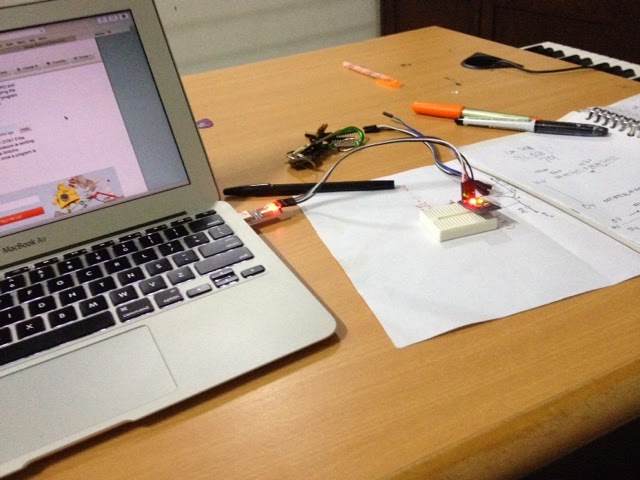Seminggu ini berusaha me-LED-kan semua lampu (kecuali lampu utama). Berguna untuk meringankan kerja aki dan alternator, :)
Seperti biasa, tak sulit, hanya tinggal ‘plug-n-play’. Lampu rem, lampu senja, semua jadi memiliki watt yang kecil.
(saya lihat spek dari lampu stock-nya adalah 24 watt untuk satu lampu rem saja, waduh berarti satu lampu menghabiskan dua ampere!)
Seperti biasa juga, ada masalah. Kedipan lampu sein jadi lebih cepat karena flasher dirancang untuk dialiri arus yang besar. Flasher memang dirancang sedemikian sehingga jika ada lampu sein yang putus maka kedipan akan lebih cepat (karena arus yang mengalir lebih kecil) untuk memperingatkan kita agar segera mengganti dengan lampu baru.
Tapi LED kan tahan lama bertahun-tahun.
Saya juga tak begitu memerlukan “fitur peringatan dini” bahwa lampu sein saya putus. Yeah, tak ada peringatan dini untuk lampu rem atau lampu senja putus kan? Kita harus selalu mengecek mereka secara manual.
Nah, fitur ini di-disable saja.
Paling mudah dengan menambahkan resistor 6 Ohm yang dipasang secara paralel dengan LED. Dengan demikian arus yang mengalir akan tetap 2 Ampere (LED hanya membutuhkan beberapa miliampere) dan flasher tetap bekerja normal, kedipan lampu sein juga normal, namun plastik batok lampu kita akan bisa leleh karena resistor melepaskan banyak panas. (yeah, cara tersebut memang mudah, lampu sein akan menyala terang karena menggunakan LED, namun arus yang mengalir akan tetap, tidak ada penghematan energi dari aki)
Yang efektif adalah dengan mengotak-atik Flashernya.
Caranya,…, DuckDuckGoing,…, dan waduh…
Banyak sekali caranya, tergantung jenis flashernya.
Secara umum, fitur untuk deteksi lampu mati terbuat dari resistor yang berbentuk kawat lengkung.
Jika flasher kita seperti ini, tinggal diamplas saja kawat lengkungnya sedikit, pasang lagi, cek, jika kedipan kurang lambat, amplas lagi, cek lagi, … dst.
Jika tidak ada resistor berbentuk kawat maka cari resistor bernama R1 kemudian ganti dengan resistor bernilai 1M Ohm. Jika Flashernya menggunaka IC, potong sambungan di kaki IC nomor 7, …. (dan banyak lagi hasil DuckDuckGo yang lain)
Saya punya dua flasher, dengan nomor kode komponen yang sama, 81980-22070, namun ketika saya buka ternyata sangat beda sekali. Satu memiliki Resistor lengkung (yeah…) dan satunya hanya terdiri dari rangkaian resistor, dioda, kapasitor dan transistor.
Cara paling mudah sebenarnya adalah dengan mengamplas Flasher saya yang punya resistor model kawat. Namun cara demikian kurang cocok bagi saya karena jika suatu saat saya ingin mengganti lagi LED dengan lampu stock maka kedipan akan jadi sangat lama atau malah tidak berkedip sama sekali.
Akhirnya saya otak-atik flasher kedua. Ganti R1 dengan resistor 1M Ohm dan,…., gagal…
Ada forum lain yang mengatakan R2 yang diganti, ok, coba lagi dan gagal, ….
Penasaran, saya balik PCB-nya, urut rangkaiannya
Tidak sulit karena tidak ada IC-nya, ini hanya semacam timer sederhana. Timer semacam ini waktunya ditentukan oleh kapasitor dan resistor yang terhubung seri sehingga saya hanya perlu cari resistor yang seperti itu dan ternyata ketemu dua yang semacam itu!
Yang satu pastilah untuk kedipan normal, yang satu untuk kedipan cepat, disable saja untuk yang kedipan cepat, yaitu yang terangkai seri dengan kapasitor yang bernilai kecil
(dalam hal ini ternyata resistor dengan label R5 yang harus saya copot, bisa disambung dengan resistor 1M Ohm atau dibiarkan copot saja)
Tes, ganti semua lampu sein kanan dengan LED, waktu kedipan ternyata sama dengan yang kiri. OK, ganti semuanya dengan LED, :)
(lampu sein = sen = reting = riting = liting, tergantung kebiasaan menyebut di masing-masing daerah, :) )
Modified LED Turn Signal Light Flasher
This week I tried to light all the lights (except the main lights). Useful to ease the work of batteries and alternators, :)
As usual, it's not difficult, just stay 'plug-n-play'. Brake lights, dusk lights, all have a small wattage.
(I see the spec from the stock light is 24 watts for just one brake light, it means that one lamp consumes two amperes!)
As always, there is a problem. Turn on the turn signal is faster because the flasher is designed to flow large currents. Flasher is designed so that if there is a broken turn signal, the flicker will be faster (due to smaller flowing currents) to warn us to immediately replace it with a new lamp.
But LEDs last a long time.
I also don't really need the "early warning feature" that my turn signal breaks. Yeah, there's no early warning for the brake lights or the dusk lights right? We must always check them manually.
Well, this feature is disabled only.
It's easiest to add a 6 Ohm resistor installed in parallel with the LED. Thus the current flowing will remain 2 Ampere (LEDs only need a few milliamperes) and the flasher will still work normally, the flashing of the turn signal is also normal, but our light shell plastic will melt because the resistor releases a lot of heat. (yeah, this method is easy, the turn signal lights up brightly because it uses LEDs, but the current flowing will remain, there is no energy savings from the battery)
What is effective is by tinkering with the Flasher.
The trick, ..., DuckDuckGoing, ..., and oh my ...
There are lots of ways, depending on the type of flasher.
In general, the feature for detection of dead lights is made of resistors in the form of curved wire.
If our flasher is like this, just sand the curved wire a little, plug it in again, check, if it blinks slowly, sandpaper again, check again, etc.
If there is no wire-shaped resistor, look for a resistor named R1 then replace it with a resistor worth 1M Ohm. If the Flasher uses IC, cut the connection at the foot of IC number 7, ... (and many other DuckDuckGo results)
I have two flasher, with the same component code number, 81980-22070, but when I open it it is very different. One has a curved resistor (yeah ...) and the other only consists of a series of resistors, diodes, capacitors and transistors.
The easiest way is actually to sand my Flasher which has a wire model resistor. However, this method is not suitable for me because if one day I want to replace the LED with the stock lights, the flashing will be very long or not even blink at all.
Finally I tweaked the second flasher. Replace R1 with a 1M Ohm resistor and, ..., fail ...
There is another forum that says R2 is replaced, ok, try again and fail, ...
Intrigued, I flipped to look the back of the circuit board, manually routing the sequence with my finger.
It's not difficult because there's no IC, it's just a simple timer. This kind of timer is determined by a series of capacitors and resistors so I only need to find a resistor like that and it turns out that I found two of them!
One must be for normal blinking, one for fast blinking, just disable it for the fast blinking, which is coupled with a series of small-value capacitors
(in this case it turns out that the resistor with the R5 label that I have to dislodge, can be connected with a 1M Ohm resistor or just left it open/disconnected)
Test, replace all the right turn signal with the LED, the flashing time is the same as the left one. OK, replace everything with LED, done, :)
















































